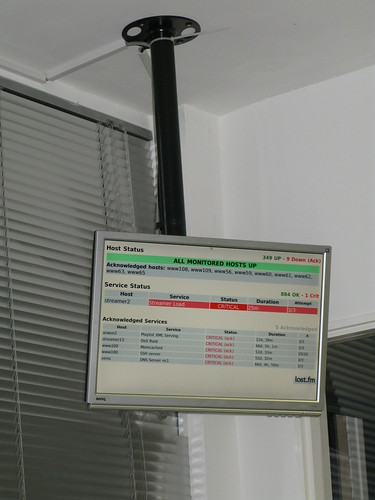It’s been a long time coming (even longer than CactiView!) but finally I’ve cleaned up (as much as possible) and released Naglite2, a full screen easy to read status screen backed on to Nagios.

Perfect for a NOC or operations room, you get a at-a-glance view of your hosts and services status, which not only helps in sudden emergencies but also incentivise your staff to get a “clean board” and fix the remaining niggly problems in your network!
The screen also compresses down quite nicely into a mobile browser, perfect for checking on the status of your systems whilst on the move.
The code is up over at Github, feel free to use/distribute/fork and modify or send me comments.
Hi!, im trying it out
I get the flowing warning:
Warning: strftime() expects parameter 2 to be long, string given in /var/www/Naglite2/inc.php on line 145
in various lines where the function is being used
any ideas?
If i scroll down i can see it working
I fixed it , i’m using nagios3.0.2 so i uncommented the code where it said:
# If you have a slightly older version of Nagios you’ll need to uncomment these. They were in the file twice in older versions.
😛
This is great! We just started using it. If you’re looking for a a list of features to add, might I recommend a date field somewhere (top left, bottom left, where ever) so that we can know the last refresh. It’s helpful if for any reason the screen freezes and everything might look normal even when it’s not.
I’ve been tasked with migrating an old Naglite2 setup to a new host, and your current version. The git published Naglite3 runs well on RHEL 6, with the status.dat set correctly: I could even RPM bundle that for RPMforge, if you like. But under RHEL 5, it requires Duration.php (which is not built in), inc.inc (which is not built in), and even when I bring those over from someone else’s old setup which they’ve manually created some time ago, I get a screen full of a published index.php contents, not an actual working Naglite.
So, is there any point for me to try to integrate Naglite2 to RHEL 5? Or am I a lot better off simply jumping to RHEL 6 and working with Naglite3?
Nico, naglite3 is not published by me.
Not sure why it would make a difference between RHEL5 and 6, however I think the default PHP configuration in RHEL doesn’t allow for “lazy” PHP opening tags (e.g. “